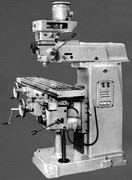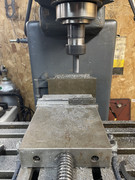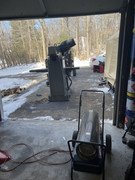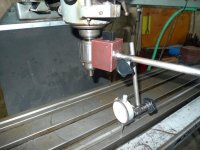How to install the app on iOS
Follow along with the video below to see how to install our site as a web app on your home screen.
Note: This feature may not be available in some browsers.
You are using an out of date browser. It may not display this or other websites correctly.
You should upgrade or use an alternative browser.
You should upgrade or use an alternative browser.
Tramming a mill without moving the head ?
- Thread starter sasanifab
- Start date
- Replies 49
- Views 6,166
plastikdreams
Diamond
- Joined
- May 31, 2011
- Location
- upstate nj
Can you shim the head? Something is out of wack, I'd poke around a bit.
CarbideBob
Diamond
- Joined
- Jan 14, 2007
- Location
- Flushing/Flint, Michigan
Four thou over what distance?
That seems big. To the table top, result of part being cut or indicating something clamped in a vise?
That seems big. To the table top, result of part being cut or indicating something clamped in a vise?
CarbideBob
Diamond
- Joined
- Jan 14, 2007
- Location
- Flushing/Flint, Michigan
This not a weenie machine and 4 thou seems so huge.Pics would help. If its a knee mill, my first thought is the knee gib is loose.
Attachments
So I have a tramming tool that is 6-7 inches apart , so the back of the table is about 4 thousands lower than the front. I guess my question is .... there must be a way to make small adjustments in the table? Maybe with the gib . The head rotates side to side but not front to back. url=https://postimg.cc/sB6ZdYs8]
 [/url]
[/url]





So your machine head tilts, but does not knod.
The high table may be overcompensation for expected setteling, wear or sag.
Loosen the knee gibs just a little, and you will be astounded how much that table will fall out front.
As the machine is a ram type, but not a Turret type (If I see correctly from the pics) My first effort would be to looseen the ram gib and slide the head out and back a few times. Also, If the machine is new to you, Loosen up the knee gibs a bit and exercise the knee a couple dozen times full travel, lots of lube.
Get the machine to settle, whether "New and tight" or "old and clogged" You want the mating parts to be truly mating.
Then double check your tramming set up. I don't have anything good to say about those double travel dial set ups.
An indi-col and a couple of feeler gauge strips oiled to the table is all I ever use.
But for vise work, I only tram the vise. it's the only part that matters '=)
The high table may be overcompensation for expected setteling, wear or sag.
Loosen the knee gibs just a little, and you will be astounded how much that table will fall out front.
As the machine is a ram type, but not a Turret type (If I see correctly from the pics) My first effort would be to looseen the ram gib and slide the head out and back a few times. Also, If the machine is new to you, Loosen up the knee gibs a bit and exercise the knee a couple dozen times full travel, lots of lube.
Get the machine to settle, whether "New and tight" or "old and clogged" You want the mating parts to be truly mating.
Then double check your tramming set up. I don't have anything good to say about those double travel dial set ups.
An indi-col and a couple of feeler gauge strips oiled to the table is all I ever use.
But for vise work, I only tram the vise. it's the only part that matters '=)
Brandenberger
Hot Rolled
- Joined
- Sep 19, 2017
maybe try this--
figure out whether your knee/table is not perpendicular to the machine, or whether the spindle/quill is not perpendicular to the table.
If you have a decent precision square, use that and feeler gages between the column and knee top, and column and table top. Try that with the knee locked and unlocked.
Note: make sure you are clear what those bolts are on the knee clamping area. Not sure on your machine, but on a machine like a K&T those aren't for adjusting the gib, they're bolting on the piece which holds the tapered gib against the back of the dovetail on the column face. Best to get a manual to confirm, and/or look for a screw at top and bottom of the knee dovetail which would pull/push the gib.
EPAIII
Diamond
- Joined
- Nov 23, 2003
- Location
- Beaumont, TX, USA
If the knee were sagging, I would expect that the front edge of the table would be lower. But you say the back edge seems to be lower.
That could be due to the ram sagging due to the weight of the head. I would clean and then LOCK DOWN the ways that the ram rides in. Then check with your two headed gauge again.
Of course, the knee should also be tight on it's dovetails while doing so.
A general rule is all adjustments on the dovetails that are not required to move for a given cut should be locked down if you want the best performance from any machine tool. And milling machines, with large weights hanging out, extended from their support dovetails, are a particularly severe example of this tendency to sag due to gravity.
That could be due to the ram sagging due to the weight of the head. I would clean and then LOCK DOWN the ways that the ram rides in. Then check with your two headed gauge again.
Of course, the knee should also be tight on it's dovetails while doing so.
A general rule is all adjustments on the dovetails that are not required to move for a given cut should be locked down if you want the best performance from any machine tool. And milling machines, with large weights hanging out, extended from their support dovetails, are a particularly severe example of this tendency to sag due to gravity.
Limy Sami
Diamond
- Joined
- Jan 7, 2007
- Location
- Norfolk, UK
John Garner
Titanium
- Joined
- Sep 1, 2004
- Location
- south SF Bay area, California
I share Limy Sami's concern. Did you set the dial gages' "zero" by 1) setting the indicator tool on a flat surface and adjusting the gages, or 2) installing the tool into the machine spindle and swinging the tool so that both gages are set with their contact points on the same spot?
Method 1 is, in my opinion, FUNDAMENTALLY wrong. Even if it's what the tool instructions might direct.
I regard this type of tool as a "nice to have" gizmo, BUT ONLY IF BOTH GAGES ARE "ZEROd" BY ROTATING THE TOOL.
Method 1 is, in my opinion, FUNDAMENTALLY wrong. Even if it's what the tool instructions might direct.
I regard this type of tool as a "nice to have" gizmo, BUT ONLY IF BOTH GAGES ARE "ZEROd" BY ROTATING THE TOOL.
eKretz
Diamond; Mod Squad
- Joined
- Mar 27, 2005
- Location
- Northwest Indiana, USA
Figure out if the top surface of the table is out of square to the knee travel first. It might well be .004" out due to wear or sag, as noted by the others. You need to begin at the beginning and understand the geometry involved before you go making any changes to anything.
Limy Sami
Diamond
- Joined
- Jan 7, 2007
- Location
- Norfolk, UK
I generally just bring the table up until the ends of the dial indicator touch , zero them out and lower the table. Check for differences
Try doing a sweep with a single indicator - if you haven't a flat disc etc a sheet of glass will suffice ..........or at least get you very close - you can always rotate the sheet of glass to see if any anomaly is the machine or glass itself.
Joe Gwinn
Stainless
- Joined
- Nov 22, 2009
- Location
- Boston, MA area
... a sheet of glass will suffice ..........or at least get you very close - you can always rotate the sheet of glass to see if any anomaly is the machine or glass itself.
Use plate glass made by the float process (where molten glass is poured out onto a big puddle of molten tin, and gravity does the rest as the glass cools). Best to get it from a mirror and glass place. Not real expensive.
gustafson
Diamond
- Joined
- Sep 4, 2002
- Location
- People's Republic
I agree with EPA that if the ram is sagging it will look like the table is high at the front. Try checking with the ram in several positions to see if it changes
This is not bound to be worn as it is not moved constantly, so may just need cleaning and adjustment
This is not bound to be worn as it is not moved constantly, so may just need cleaning and adjustment
Peter S
Diamond
- Joined
- May 6, 2002
- Location
- Auckland, New Zealand
I used to use a Rambaudi back when I was an apprentice.
I was warned that the head was "a little out" because the Z axis power feed had been left engaged and the vise, workpiece or whatever had eventually hit the stationary spindle and tried to lift it up...
From memory, the feed lever was moved down for feed, up for rapids. If the spring detent was a bit loose, maybe it would even fall down by itself.
The feed motor was quiet. It kept running when the spindle was off.
So it was conceivable that someone (an idiot, mind you) might walk off without noticing the Z axis was on its way up - slowly, slowly, bang.
There was no "nod" on that mill, just tilt.
You guys and your tramming techniques . Just sweep the table with your plunger-type indicator, allowing the plunger to run up and over the tee slots! It doesn't harm the indicator! You only need to have the indicator showing a few thou.
. Just sweep the table with your plunger-type indicator, allowing the plunger to run up and over the tee slots! It doesn't harm the indicator! You only need to have the indicator showing a few thou.
What's that? You had to bend your neck a bit to read the indicator? So sorry


I was warned that the head was "a little out" because the Z axis power feed had been left engaged and the vise, workpiece or whatever had eventually hit the stationary spindle and tried to lift it up...
From memory, the feed lever was moved down for feed, up for rapids. If the spring detent was a bit loose, maybe it would even fall down by itself.
The feed motor was quiet. It kept running when the spindle was off.
So it was conceivable that someone (an idiot, mind you) might walk off without noticing the Z axis was on its way up - slowly, slowly, bang.
There was no "nod" on that mill, just tilt.
You guys and your tramming techniques
 . Just sweep the table with your plunger-type indicator, allowing the plunger to run up and over the tee slots! It doesn't harm the indicator! You only need to have the indicator showing a few thou.
. Just sweep the table with your plunger-type indicator, allowing the plunger to run up and over the tee slots! It doesn't harm the indicator! You only need to have the indicator showing a few thou.What's that? You had to bend your neck a bit to read the indicator? So sorry



Similar threads
- Replies
- 31
- Views
- 2K




